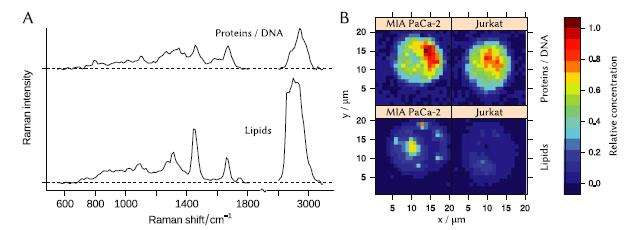Researchers can now build an inexpensive and flexible micro-Raman system

Raman spectroscopy provides detailed chemical information, and when combined with a microscope, it can non-destructively analyze biological samples. While commercial research-grade Raman microscopes have been available for some time, they have tended to be both inflexible and very expensive. In a paper in the current issue of Biomedical Spectroscopy and Imaging, researchers from Germany and Serbia describe an inexpensive, versatile micro-Raman system that can be assembled from readily available components at a fraction of the cost of a commercial tool.
Because micro-Raman spectroscopy combines chemical characterization with imaging in a label-free way, it is particularly well suited for biological research because it can detect variations in biomolecular composition and correlate that information with corresponding biological changes due to metabolism or pathology. It also holds promise for rapid clinical diagnosis in living cells and a host of applications, such as observation of cell metabolism, growth, and aging, studies of drug resistance or drug uptake, chemical mapping of cells, and many others. Since disease typically originates at the cellular level, this capability could help us understand how changes within an individual cell could lead to disease development.
To build this microscope, the authors obtained more than 20 components, ranging from mirrors and filters to cameras, lenses, and a motorized table. They estimate that their design could be built for about €10,000 and requires only normal expertise in optical assembly.
In terms of flexibility, this microscope can be switched from an upright to an inverted configuration, an unusual and important advantage for analyzing biological samples. It is particularly effective for hyperspectral imaging, through which the chemical composition of each pixel in a scanned image can be determined. In addition to Raman spectroscopy, the system can be combined with other modalities such as fluorescence imaging.
The microscope was used to collect Raman maps of individual cells from two different cancer cell lines, MIA PaCs-2 pancreatic cancer and Jurkat, T-Lymphocytes. By collecting the spectra at each point, the relative concentrations of lipids vs. proteins/DNA were mapped.
According to lead investigator Prof. Jürgen Popp, PhD, of the Leibniz Institute of Photonic Technology and the Institute of Physical Chemistry and Abbe Center of Photonics, University Jena (Germany), the development of this instrument embodies their institute's mission, "From ideas to instruments." The responsible researcher Christoph Krafft, PhD, explained that "We acquired Raman images of single human cells with a custom instrument. These data demonstrated that the instrument provides spectra of sufficient quality to distinguish the cell type. This result will be exploited in projects about identification of tumor cells circulating in blood."
More information: Roman Kiselev et al, Design and first applications of a flexible Raman micro-spectroscopic system for biological imaging, Biomedical Spectroscopy and Imaging (2016). DOI: 10.3233/BSI-160141
Journal information: Biomedical Spectroscopy and Imaging
Provided by IOS Press


















